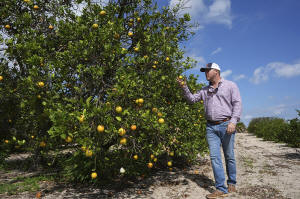Florida's citrus industry faces threats from hurricanes, disease and
real estate
[March 14, 2025] By
MIKE SCHNEIDER
LAKE WALES, Fla. (AP) — As Trevor Murphy pulls up to his dad's 20-acre
(8-hectare) grove in one of the fastest-growing counties in the United
States, he points to the cookie-cutter, one-story homes encroaching on
the orange trees from all sides.
“At some point, this isn't going to be an orange grove anymore," Murphy,
a third-generation grower, says as he gazes at the rows of trees in Lake
Wales, Florida. "You look around here, and it's all houses, and that's
going to happen here.”
Polk County, which includes Lake Wales, contains more acres of citrus
than any other county in Florida. And in 2023, more people moved to Polk
County than any other county in the country.
Hit in recent years by hurricanes and citrus greening disease, which
slowly kills the trees, many growers are making the difficult decision
to sell orange groves that have been in their families for generations
to developers building homes to house the growing population.
Others, like Murphy, are sticking it out, hoping to survive until a
bug-free tree or other options arrive to repel the disease or treat the
trees.
Mounting concerns
When Hurricane Irma blasted through the state's orange belt in 2017,
Florida's signature crop already had been on a downward spiral for two
decades because of the greening disease. Next came a major freeze and
two more hurricanes in 2022, followed by two hurricanes last year. A
tree that loses branches and foliage in a hurricane can take three years
to recover, Murphy said.

Those catastrophes contributed to a 90% decline in orange production
over the past two decades. Citrus groves in Florida, which covered more
than 832,00 acres (336,698 hectares) at the turn of the century,
populated scarcely 275,000 acres (111,288 hectares) last year, and
California has eclipsed Florida as the nation's leading citrus producer.
“Losing the citrus industry is not an option. This industry is ... so
ingrained in Florida. Citrus is synonymous with Florida,” Matt Joyner,
CEO of trade association Florida Citrus Mutual told Florida lawmakers
recently.
Nevertheless, Alico Inc., one of Florida’s biggest growers, announced
this year that it plans to wind down its citrus operations on more than
53,000 acres (21,000 hectares), saying its production has declined by
almost three-quarters in a decade.
That decision hurts processors, including Tropicana, which rely on
Alico’s fruit to produce orange juice and must now operate at reduced
capacity. Orange juice consumption in the U.S. has been declining for
the past two decades, despite a small bump during the COVID-19 pandemic.
A prominent growers group, the Gulf Citrus Growers Association, closed
its doors last year.
Location, location, location
Pressure on citrus farming is also growing from one of the state's other
biggest industries: real estate.
Florida expanded by more than 467,000 people last year to 23 million
people, making it the third largest state in the nation. And more homes
must be built to house that ever-growing population.
[to top of second column] |

Trevor Murphy, inspects an orange tree in one of his groves,
Tuesday, Feb. 18, 2025, in Sebring, Fla. Murphy, whose family has
been growing oranges for generations, is hoping for a cure to citrus
greening, a bacterial infection that together with other factors has
decimated the industry. (AP Photo/Marta Lavandier)
 Some prominent, multi-generational
citrus families each have been putting hundreds of acres (hectares)
of groves up for sale for millions of dollars, or as much as $25,000
an acre.
Murphy owns several hundred acres (hectares) of groves and says he
has no plans to abandon the industry, though last year he closed a
citrus grove caretaking business that managed thousands of acres for
other owners.
However, he also has a real estate license, which is useful given
the amount of land that is changing hands. He recently sold off
acres in Polk County to a home developer, and has used that money to
pay off debt and develop plans to replant thousands of trees in more
productive groves.
“I would like to think that we’re at the bottom, and we’re starting
to climb back up that hill,” Murphy says.
A bug-free tree
A whole ecosystem of businesses dependent on Florida citrus is at
risk if the crops fail, including 33,000 fulltime and part-time jobs
and an economic impact of $6.8 billion in Florida alone. Besides
growers, there are juice processors, grove caretakers, fertilizer
sellers, packing houses, nurseries and candy manufacturers, all
hoping for a fix for citrus greening disease.
Tom Davidson, whose parents founded Davidson of Dundee Citrus Candy
and Jelly Factory in Lake Wales in 1966, says the drop in citrus
production has impacted what flavor jellies the business is able to
produce and the prices it charges to customers.
“We’re really hoping that the scientists can get this figured out so
we can we can get back to what we did,” Davidson says.
Researchers have been working for eight years on a genetically
modified tree that can kill the tiny insects responsible for citrus
greening. The process involves inserting a gene into a citrus tree
that produces a protein that can kill baby Asian citrus psyllids by
making holes in their guts, according to Lukasz Stelinski, an
entomology professor at the University of Florida/Institute of Food
and Agricultural Sciences' Citrus Research and Education Center.

It could be at least three years before bug-resistant trees can be
planted, leaving Florida growers looking for help from other
technologies. They include planting trees inside protective screens
and covering young trees with white bags to keep out the bugs,
injecting trees with an antibiotic, and finding trees that have
become resistant to greening through natural mutation and
distributing them to other groves.
“It’s kind of like being a Lions fan before the Detroit Lions
started to win games,” Stelinski says. “I'm hoping that we are
making that turnaround.”
All contents © copyright 2025 Associated Press. All rights reserved |